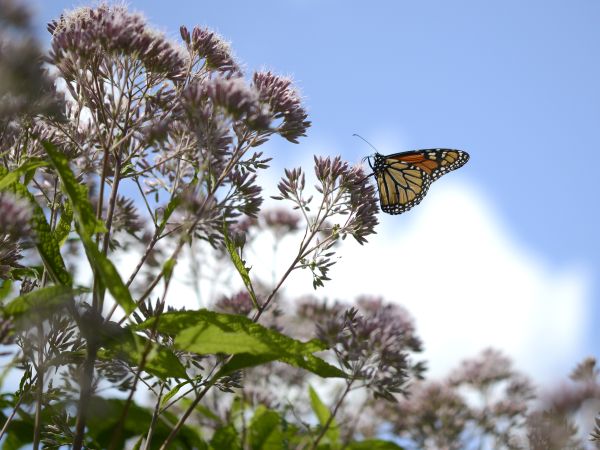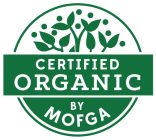How To Make A Garden With Bare Root Perennials
Are you ready to get your hands in the soil this spring?
To plant some things that can and will make a difference in this uncertain world?
Perennial plants can help you keep busy creating positive changes in your world in a variety of ways by:
- providing habitat and food for wildlife like birds, bees and other beneficial insects,
- providing food for you directly by being edible,
- and by providing beauty and happiness during this chaotic time.
If starting or adding to your perennial garden leaves you with questions, I can help! Read through my guide below and learn how to make a garden with bare root perennials!

Photo credit: Mary Sue Henszey
Step #1 Plan your garden's purpose
When planning a garden, you'll be most satisfied with the result if you have a clear goal in mind. Here are some questions to think about if you're still clarifying your garden goals for the season:
What kinds of plants are right for me?
- What function do I want my garden to have?
- Food for me?
- Food for beneficials?
- Beauty for everyone?
- Easy to put in and to care for?
- What colors do I want?
- What heights do I want?
- What seasons do I want to see flowers?
When it comes to gardening let’s start with the most basic of definitions. Perennial vs annual, what are we talking about? Here are some definitions of common garden terms to help you figure out what is what and what you want for your garden.
Perennials:
A perennial plant is one that comes back every year. Herbaceous perennial plants grow lots of vegetation in the summer (including often flowers) and then die back to the ground with only brown leaves or stalks sticking up to indicate where they were. Woody perennial plants like shrubs, trees, bushes, etc. also come back every year and have woody stems that stick up all winter, even if they have lost their leaves.
Annuals:
Annual plants die in the fall/winter. These are most commonly like the veggies, herbs, and flowers that are planted in a typical garden. They do not come back every year.
Edible plants:
An edible perennial plant is one which has at least one edible part of the plant at some point during the year, leaves, roots, fruits, etc.
Medicinal plants:
A medicinal perennial plant is one from which you can derive an herbal medicine from some portion of the plant during its growth cycle, leaves, roots, flowers, or fruits.
Native plants:
In the U.S., a native plant generally refers to a species that was present and growing in America prior to European contact.
So what, you ask?
Why native plants matter:
- Wildlife & Biodiversity value:
Native plants are much more valuable to the wildlife that surround us than non-native plants. Most butterflies and moths in their larval stage as caterpillars are herbivores adapted mostly to consuming certain native plant species that they have evolved with over millennia. And most birds, whatever they may eat as adults, feed their young nearly exclusively on caterpillars and other insects. Growing native plants provides the food sources that baby birds and caterpillars need to successfully mature into the birds and butterflies that we want in our gardens and yards. - Fragmentation and human managed ‘nature’:
The reality is that humans control what the landscape looks like and what it is planted to for a vast majority of this country and this world. When we plant native plants it helps the wildlife (birds, insects, butterflies, etc.) to still have food and be able to survive within our fragmented landscapes, thereby effectively piecing nature back together right in our backyards. - Hardiness and Resilience:
Native plants are naturally adapted to the climate of the region that they are native to. They are naturally hardy and are likely to survive the winter and come back every year. Because they have adapted to the region they are also more resilient in terms of a changing climate as well as more likely to thrive without costly supports like irrigation, pesticides, and chemical fertilizers.
Step #2 Select your garden site:
There are a few things to consider when making a garden site.
Sunlight is obviously a big one.
As far as perennials go there are some that tolerate more shade than others. Evaluate your garden site and consider how much sunlight vs shade it gets when the leaves are on the trees.
Examples of native plants for sunny areas with average soil:
- Achillea millefolium Common yarrow*
- Asclepias incarnata Rose milkweed*
- Asclepias syriaca Common milkweed*
- Chelone glabra Turtlehead
- Clematis virginiana Virgins bower clematis*
- Doellingeria umbellata Tall white aster
- Echinacea pupurea Purple coneflower*
- Eupatorium perfoliatum Boneset
- Euthamia graminifolia Grass leaved goldenrod
- Eutrochium fistulosum Hollow Stem Joe pye weed*
- Eutrochium maculatum Spotted Joe pye weed
- Liatris novae-angliae Northern blazing star
- Monarda fistulosa Wild Bergamot*
- Penstemon hirsutus Northeastern beardtongue
- Solidago canadensis Canada goldenrod
- Symphyotrichum novae-angliae New England aster*
- Vernonia noveboracensis New York ironweed
(*plants that we are offering for sale in 2020)
Examples of native plants for shady areas:
- Actaea rubra Red baneberry
- Ageratina altissima White snakeroot
- Anemone virginiana Tall Thimbleweed*
- Aquilegia candensis Wild columbine*
- Dennstaedtia punctilobula Hayscented Fern*
- Eurybia macrophylla Big leaf aster
- Fragaria virginiana Wild Strawberry*
- Geranium maculatum Cranesbill geranium
- Lobelia cardinalis Cardinal flower*
- Tiarella cordifolia Foam flower
- Solidago caesia Blue Stem goldenrod*
- Viola spp. Violets
(*plants that we are offering for sale in 2020)
Moisture level is also important to consider.
Some plants can handle and even thrive in wet areas, while others are more suited to “regular” garden soil or to dry conditions.
Examples of native plants for wet areas:
- Asclepias incarnata Rose milkweed*
- Chelone glabra Turtlehead
- Eupatorium perfoliatum Boneset
- Eutrochium fistulosum Hollow Stem Joe Pye weed*
- Eutrochium maculatum Spotted Joe Pye Weed
- Iris versicolor Blue Flag Iris*
- Lobelia cardinalis* Cardinal flower*
- Lobelia siphilitica* Blue lobelia
- Tiarella cordifolia* Foam flower
- Verbena hastata Blue vervain*
- Vernonia noveboracensis New York ironweed
(*plants that we are offering for sale in 2020)
Examples of native plants for poor/dry soil (and full sun):
- Asclepias syriaca Common milkweed*
- Asclepias tuberosum Butterfly weed*
- Euthamia graminifolia Grass leaved goldenrod
- Fragaria virginiana Wild Strawberry*
- Liatris spicatum Northern blazing star
- Solidago puberula Downy goldenrod
- Solidago sempervirens Seaside goldenrod*
(*plants that we are offering for sale in 2020)
And then physical location is important, too.
Like for example proximity to your house based on your selected purpose.
Do you want to see the wildlife (aka birds, butterflies, insects buzzing, etc.) from where you often spend time? I find that having my gardens close to the places on my property that I frequent the most helps me enjoy them as well as take care of them!
Examples of native plants for monarch forage:
- Asclepias incarnata Rose milkweed*
- Asclepias syriaca Common milkweed*
- Echinacea pupurea Purple coneflower*
- Eupatorium perfoliatum Boneset
- Eutrochium fistulosum Hollow Stem Joe Pye weed*
- Eutrochium maculatum Spotted Joe Pye weed
- Symphyotrichum novae-angliae New England aster*
- Vernonia noveboracensis New York ironweed
(*plants that we are offering for sale in 2020)
Step #3 Pick your plants
Take the thoughts that you’ve generated from the two above categories and pick out the plants that will
- meet your goals, and
- work in your particular site.
Sign up for our email list to be notified of when we have plants available to order:
And don't think we'll leave you in the lurch after you get your plants...
Check out the last step below for what to do next!
Step #4 How to handle and plant bare root plants
Once you get your plants here are some tips and guidelines for handling them.
Planting:
When to plant your bare root plants:
Now, ideally. Bare root plants are happiest in the ground. They should be planted as soon as possible. If immediate planting is not possible, see the storage tips below.
Unlike greenhouse-grown plants, bare-root plants can be planted during cold weather or anytime the soil is not frozen. These are hardy perennials. Cool and damp spring conditions are just what they need to make a smooth transition to a new home.
How to plant your bare root plants:
Dig a hole deep enough for the roots to comfortably spread out and/or hang down. A comfortable plant is a happy plant. Fill in around the roots with soil and gently firm them in to settle them in their new home. Try to bring the soil level flush to the top of the crown of the plant, matching the level that the plant previously experienced while growing.
Once planted, water thoroughly. Water is the chicken soup for a newly transplanted perennial’s soul. Unless conditions are excessively dry or you have very well drained soil one thorough watering at the time of planting is generally sufficient to send your perennial on its way to new growth.
Storage and handling:
If you are unable to plant right away, it is important to keep your plants happy by meeting their basic needs.
Moisture:
Happy bare root perennials are stored to keep the roots:
- Not too dry and desiccating;
- Not too wet and saturated;
- Just right (think Goldilocks here), all nice and gently moist.
Temperature and Light:
Happy bare root perennials like the cool and dark. Ideally, plants should be stored in a refrigerator (34-38° F) before planting. Next best is a cool, shady spot. Warmer temperatures or direct sunlight can cause excessive premature growth or mold in the bag or cause the roots to dry out. Freezing can damage or kill the roots, especially when they’ve already begun to grow.
Air:
A happy bare root perennial can breathe, but doesn’t like drafts. Don’t seal shut the plastic bag. Just leave it loosely shut.
Further Resources for Native Plants
- Lady Bird Johnson Wildflower Center based in Texas is a national clearinghouse of information on native plants. They maintain a searchable database by state of native plants for various site conditions at https://www.wildflower.org/plants
- Native Plant Trust (formerly New England Wildflower Society) based in Massachusetts is a regional goldmine of information on native plants.
- Wild Seed Project based in Maine is a local resource for seeds and information about native plants.
- Prairie Moon Nursery is a Minnesota based native plant seed company. If you want to see what different native plants look like, their website and catalog are great resources.
Good luck! Hope this info helps you plant the perennial garden of your dreams! And remember we have hardy organic plants available grown right here on our farm.
Sign up for our email list to get notified when our plants will be ready to order:



Add new comment